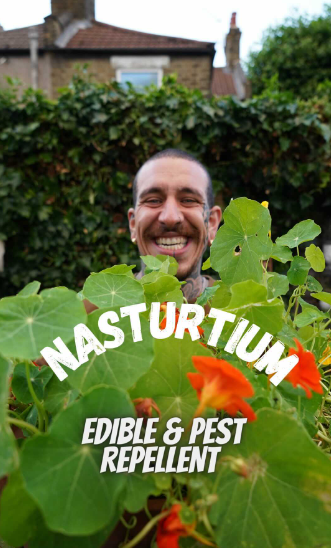Nasturtium is one of those plants that every beginner or advanced gardener must have in their growing space! I plant it every season in either pots or corners of the raised beds, and when it gets completely full of pests, I just chop off the plant at the base and dispose of it.
Yup, they’re the natural pest repellent! Garden pests like green and black flies are attracted to this plant, especially the yellow varieties. They are also known to deter whiteflies, cucumber beetles, and other pests.
Nasturtium is used as a sacrificial plant because pests will simply infest your nasturtium plant, leaving your main garden crop undisturbed.
Why Nasturtiums?
Nasturtiums, known scientifically as Tropaeolum majus, are more than just eye candy. These easy-to-grow plants serve a dual purpose in your garden. Aside from acting as a natural pest repellent and reducing the need for harmful chemical pesticides, they are also completely edible, including flowers, leaves, stems, and seeds. (I’m not a big fan of the peppery flavor but I’m working on it ????)
The name means “nose twister,” referring to people’s reaction upon tasting the peppery flowers. The seeds were used during World War II to replace pepper. They could also be fermented and they could replace capers!


Planting Your Nasturtiums
Planting nasturtiums is easy, making them perfect for new gardeners or those looking to add a low-maintenance yet beneficial plant to their garden. Here’s how you can get started:
Choose the Right Spot:
Nasturtiums thrive in full sun but can tolerate partial shade. Select a spot in your garden that receives at least 6-8 hours of sunlight per day.
Prepare the Soil:
Nasturtiums are not picky about soil quality and can grow in poor or average soil. However, they prefer well-draining soil with a slightly acidic to neutral pH. (Quick tip: Amend the soil with compost if it’s too compacted or lacks nutrients.)
Sow the Seeds:
Nasturtium seeds are large and easy to handle, making them perfect for direct sowing. Plant the seeds about 1 inch deep and 10–12 inches apart. Water gently after planting to settle the soil.
Watering and Care
Keep the soil consistently moist but not waterlogged. Nasturtiums are drought-tolerant once established, but regular watering promotes lush foliage and abundant flowering.
Watch Them Grow:
Nasturtiums are fast growers and will start blooming within a few weeks of planting. Enjoy the colorful display of flowers, and watch as beneficial insects are attracted to your garden.
Harvesting:
Both the leaves and flowers of nasturtiums are edible. Harvest them as needed by pinching or cutting them from the plant. Regular harvesting encourages more growth and flowering.
Gardeners, remember that it’s not too late to protect your plants. And whether you’re looking to add color to your garden, repel pests naturally, or enjoy their edible flowers and leaves, nasturtiums are sure to help.
Follow these simple steps in this blog, and you’ll soon harvest your own sacrificial plant – a great addition and ally in your thriving and growing garden.

